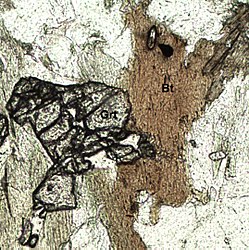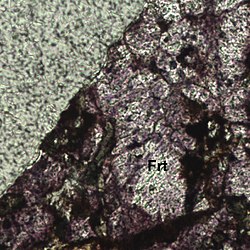Relief (microscopy)
In geology, a relief is an optical effect when microscopic thin sections of rocks are used . The relief enables an initial, rough estimate of the refractive index of minerals.
description
The relief of a mineral is the effect that when examined under a microscope, the surface of a mineral appears spatially pronounced. A distinction is made between positive relief and negative relief.
The surface of a mineral with a positive relief appears to be lifted out of the ground plane. The surface of a mineral with a negative relief, on the other hand, appears to be offset backwards in relation to the plane of the cut. Minerals with a refractive index greater than that of the embedding medium have a positive relief. The greater the difference in the refractive indices, the more clearly the mineral appears to be emphasized. Conversely, if a mineral has a refractive index smaller than the embedding medium, its relief is negative.
gallery
Thin section with garnet (Grt) and biotite (Bt). Minerals of the garnet group have a very high light refraction (approx. 1.8) and therefore show a strong relief. Biotite, on the other hand, has a lower refraction (approx. 1,605) and therefore does not appear as three-dimensional. Image width 650 microns.
Thin section with fluorite (Frt) against the embedding medium (top left). Fluorite has a light refraction of 1.44, which is lower than that of the embedding medium (1.54). Therefore, fluorite shows a slight negative relief. Image width 530 micrometers.
Thin section showing a quartz (Qrz), a garnet (Grt) and a pyroxene (Pyx). The quartz has almost the same refraction as the embedding medium (1.54) and therefore does not show any relief. In contrast to quartz, the garnet on the left and the pyroxene on the right appear clearly raised. Minerals of the pyroxene group have an increased refraction of light (e.g. augite with approx. 1.7) and garnets have a very high refraction. Image height approx. 1 millimeter.
literature
- WS MacKenzie, AE Adams: Color Atlas of Rocks and Minerals in Thin Section . 12th edition. Manson Publishing, London 2013, ISBN 978-1-874545-17-0 , pp. 18-19 .
- Hans Pichler, Cornelia Schmitt-Riegraf: Rock -forming minerals in thin sections . Enke, Stuttgart 1987, ISBN 3-432-95521-9 , pp. 8 .


